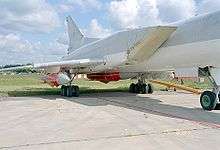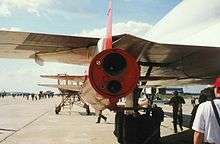Kh-22
| Kh-22 (NATO reporting name: AS-4 'Kitchen') | |
|---|---|
 Kh-22 under a Tu-22M2 | |
| Type | Air-to-surface missile |
| Place of origin | Soviet Union |
| Service history | |
| Used by | Russia |
| Production history | |
| Designer | MKB Raduga |
| Produced | 1962 |
| Specifications | |
| Weight | 5,820 kg (12,800 lb) |
| Length | 11.65 m (38.2 ft) |
| Diameter | 92 cm (36 in) |
| Warhead |
1,000 kg (2,205 lb) RDX or 350–1,000 kiloton nuclear weapon |
|
| |
| Engine | Liquid-fuel rocket |
| Wingspan | 300 cm (120 in) |
| Propellant | Tonka-250 and IRFNA |
Operational range | 600 km (320 nmi) (Kh-22M/MA)[1] |
| Flight ceiling | 10-14 km or 27 km |
| Speed | Mach 4.6 (5,635.2 km/h; 3,501.6 mph)[2] |
Guidance system | Inertial guidance followed by terminal active radar homing |
Launch platform | Tu-22M, Тu-22К, Тu-95К22 |
The Kh-22 (Russian: Х-22; AS-4 'Kitchen') is a large, long-range anti-ship missile developed by MKB Raduga in the Soviet Union. It was intended for use against US Navy aircraft carriers and carrier battle groups, with either a conventional or nuclear warhead.
Development
After analyzing World War II naval battles and encounters in the late 1940s and early 1950s, Soviet military thinkers concluded that the era of large seaborne battles was over, and that stand-off attacks would be the way to neutralize and incapacitate large battle groups without having to field a similar force against them. Substituting cruise missiles for air attacks, Soviet Air Forces and Soviet Naval Aviation commanders set about to convert their heavy bombers to raketonosets, or missile carriers, which could be launched against approaching enemy fleets from coastal or island airfields. The Kh-22 (Complex 22) weapon was developed by the Raduga design bureau and used to arm the Tupolev Tu-22M.
Design
The Kh-22 uses an Tumanski liquid-fuel rocket engine, fueled with TG-02 (Tonka-250) and IRFNA (inhibited red fuming nitric acid), giving it a maximum speed of Mach 4.6 and a range of up to 600 km (320 nmi). It can be launched in either high-altitude or low-altitude mode. In high-altitude mode, it climbs to an altitude of 27,000 m (89,000 ft) and makes a high-speed dive into the target, with a terminal speed of about Mach 4.6. In low-altitude mode, it climbs to 12,000 m (39,000 ft) and makes a shallow dive at about Mach 3.5, making the final approach at an altitude under 500 m (1,600 ft). The missile is guided by a gyroscope-stabilized autopilot in conjunction with a radio altimeter.
Soviet tests revealed that when a shaped charge warhead weighing 1,000 kg (2,200 lb) was used in the missile, the resulting hole measured 5 m (16 ft) in diameter (19.63 m2 (211.3 sq ft)), and was 12 m (40 ft) deep.[3][4][5][6][7][8][9]
By August 2016, Russia was finalizing the trials of the Kh-32 cruise missile, a derivative of the Kh-22. Designed for use by the Tu-22M3 bomber, the missile is designed to climb to 40 km (130,000 ft) to the stratosphere after launch, transition to level flight, then perform a steep dive to the target; its combination of speed and flight path makes it virtually invulnerable to interception by ground-based air defenses and fighters. The advanced cruise missile is designed to target enemy ships, radars, and "radio-contrast targets" like bridges, military bases, electric power plants, and others. The Kh-32 has an inertial navigation system and radar homing head, making it independent of GPS/GLONASS navigation satellites. Presumably, it has a range of 1,000 km (620 mi; 540 nmi) and a speed of at least 5,000 km/h (3,100 mph; Mach 4.1).[10] Apparently the missile entered service in the same year.[11] 32 Kh-22 missiles will be modernized to the Kh-32 level in 2018-2020.[12]
Operational history

The first service-ready missiles were ready in 1962.
The main launch platform is the Tu-22M 'Backfire'.[13][14] It was also used by Soviet and then Russian air forces on the Тu-22К ('Blinder-B') and Tu-95К22 ('Bear-G').
Variants
Two initial versions were built, the Kh-22 with a large conventional warhead and the Kh-22N with a 350–1000-kiloton nuclear warhead.[15] In the mid-1970s this was supplemented by the Kh-22P, an anti-radiation missile for the destruction of radar installations. In the 1970s the Kh-22 was upgraded to Kh-22M and Kh-22MA standard, with new attack profiles, somewhat longer range, and a datalink allowing mid-course updates.
- Kh-22E — a conventional variant for export.
- Kh-22M/MA — upgraded variants with Mach 3.3 speed and 600 km (370 mi) range. Weighs 5,780 kilograms (12,740 lb), contains 960 kilograms (2,120 lb) of RDX.[16][17]
- Kh-32 — a radically upgraded conventional/nuclear variant of Kh-22 with Mach 5 speed and 1,000 km (620 mi) range.[10][18] It features an improved rocket motor and a new seeker head. Currently produced for the Tu-22M3 launch platform.[19] Warhead weight has been reduced to 500 kg (1,100 lb) to improve range.[20]

Operators
Former operators
Notes
- ↑ ausairpower, Anti Shipping Missile Survey, ausairpower, p. Air-Launched Cruise Missiles
- ↑ Scribd, Anti Shipping Missile Survey, Scribd, p. 37
- ↑ Precision Guided Munitions in the Region, Technical Report APA-TR-2007-0109, 2004 - 2012 Carlo Kopp, ausairpower.net
- ↑ КРЫЛАТАЯ РАКЕТА Х-22Н "Буря", Д-2Н, AS-4 Kitchen, Образцы вооружений Военно - морского флота, vs.milrf.ru
- ↑ http://vs.milrf.ru/armament/marine/krm_x22.htm
- ↑ http://rbase.new-factoria.ru/missile/wobb/x22/x22.shtml
- ↑ https://topwar.ru/37561-krylataya-raketa-h-22.html
- ↑ https://defendingrussia.ru/enc/pkr/protivokorabelnaja_krylataja_raketa_vozdushnogo_bazirovanija_kh22_burja-1466/
- ↑ http://biblioteka.mycity-military.com/biblioteka/cyber%20fulkrum/E%20N%20G%20L%20E%20S%20K%20I/AC%204%20Publication%20i%20drugo/AC_-_Tupolev_Tu-22_BLINDER___Tu-22M_BACKFIRE_Russia_s_Long_Range_Supersonic_Bombers.pdf
- ↑ https://sputniknews.com/military/201711171059192743-tu-22-bomber-new-missiles/
- ↑ https://www.navyrecognition.com/index.php/news/defence-news/2018/may-2018-navy-naval-defense-news/6227-russian-mod-to-upgrade-32-kh-22-long-range-anti-ship-missiles.html
- ↑ Rosoboronexport Air Force Department and Media & PR Service, AEROSPACE SYSTEMS export catalogue (PDF), Rosoboronexport State Corporation, p. 122, archived from the original (PDF) on 2007-10-30
- ↑ China's Military Faces the Future, James R. Lilley, David L. Shambaugh, illustrated, M.E. Sharpe, 1999, ISBN 0765605066, ISBN 9780765605061
- ↑ В Полтаве готовятся к утилизации последнего бомбардировщика, 26 Jan 2006, aviaport.ru
- ↑ http://www.ausairpower.net/APA-Rus-Cruise-Missiles.html
- ↑ https://books.google.pl/books?id=BrLgAwAAQBAJ&pg=PA100&lpg=PA100&dq=kh-22m+missile&source=bl&ots=aHerK3CiL1&sig=Bd8MOyvholOHWC9vTWOI3jw3-xk&hl=pl&sa=X&ved=0ahUKEwiwwvab0cXYAhUIY98KHad5C70Q6AEIVDAJ#v=onepage&q=kh-22m%20missile&f=false
- ↑ http://sputniknews.com/voiceofrussia/2012_03_07/67853512/
- ↑ http://www.eng.ktrv.ru/news/publ/830.html?PHPSESSID=b55062d53f861256438076e6c6d01f44
- ↑ http://www.upi.com/Business_News/Security-Industry/2016/08/30/New-Russian-cruise-missiles-to-hit-targets-from-130000-feet/4301472562569/
- ↑ В Полтаве готовятся к утилизации последнего бомбардировщика, 26.01.2006, http://www.aviaport.ru
References
- Gordon, Yefim (2004). Soviet/Russian Aircraft Weapons Since World War Two. Hinckley, England: Midland Publishing. ISBN 1-85780-188-1.
External links
| Wikimedia Commons has media related to Raduga Kh-22. |
- http://airwar.ru/weapon/kr/x22.html (in Russian)
- New Kh-32 Antiship Missile Becomes Operational in Russia - part 1 Navy Recognition
- New Kh-32 Antiship Missile Becomes Operational in Russia - part 2 Navy Recognition